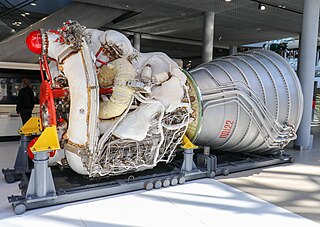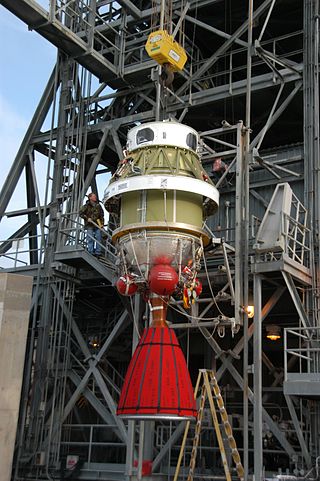Related Research Articles

The Army Ballistic Missile Agency (ABMA) was formed to develop the U.S. Army's first large ballistic missile. The agency was established at Redstone Arsenal on 1 February 1956, and commanded by Major General John B. Medaris with Wernher von Braun as technical director.

The PGM-11 Redstone was the first large American ballistic missile. A short-range ballistic missile (SRBM), it was in active service with the United States Army in West Germany from June 1958 to June 1964 as part of NATO's Cold War defense of Western Europe. It was the first US missile to carry a live nuclear warhead, in the 1958 Pacific Ocean weapons test, Hardtack Teak.

Rocketdyne was an American rocket engine design and production company headquartered in Canoga Park, in the western San Fernando Valley of suburban Los Angeles, in southern California.

The PGM-17A Thor was the first operative ballistic missile of the United States Air Force (USAF). It was named after the Norse god of thunder. It was deployed in the United Kingdom between 1959 and September 1963 as an intermediate-range ballistic missile (IRBM) with thermonuclear warheads. Thor was 65 feet (20 m) in height and 8 feet (2.4 m) in diameter.

The Delta rocket family is a versatile range of American rocket-powered expendable launch systems that has provided space launch capability in the United States since 1960. Japan also launched license-built derivatives from 1975 to 1992. More than 300 Delta rockets have been launched with a 95% success rate. The series has been phased-out in favor of the Vulcan Centaur, with only the Delta IV Heavy rocket remaining in use as of June 2023.

The PGM-19 Jupiter was the first nuclear armed, medium-range ballistic missile (MRBM) of the United States Air Force (USAF). It was a liquid-propellant rocket using RP-1 fuel and LOX oxidizer, with a single Rocketdyne LR79-NA rocket engine producing 667 kilonewtons (150,000 lbf) of thrust. It was armed with the 1.44 megatons of TNT (6.0 PJ) W49 nuclear warhead. The prime contractor was the Chrysler Corporation.

The F-1, commonly known as Rocketdyne F-1, was a rocket engine developed by Rocketdyne. This engine uses a gas-generator cycle developed in the United States in the late 1950s and was used in the Saturn V rocket in the 1960s and early 1970s. Five F-1 engines were used in the S-IC first stage of each Saturn V, which served as the main launch vehicle of the Apollo program. The F-1 remains the most powerful single combustion chamber liquid-propellant rocket engine ever developed.

The Rocketdyne H-1 was a 205,000 lbf (910 kN) thrust liquid-propellant rocket engine burning LOX and RP-1. The H-1 was developed for use in the S-I and S-IB first stages of the Saturn I and Saturn IB rockets, respectively, where it was used in clusters of eight engines. After the Apollo program, surplus H-1 engines were rebranded and reworked as the Rocketdyne RS-27 engine with first usage on the Delta 2000 series in 1974. RS-27 engines continued to be used up until 1992 when the first version of the Delta II, Delta 6000, was retired. The RS-27A variant, boasting slightly upgraded performance, was also used on the later Delta II and Delta III rockets, with the former flying until 2018.

The RL10 is a liquid-fuel cryogenic rocket engine built in the United States by Aerojet Rocketdyne that burns cryogenic liquid hydrogen and liquid oxygen propellants. Modern versions produce up to 110 kN (24,729 lbf) of thrust per engine in vacuum. Three RL10 versions are in production for the Centaur upper stage of the Atlas V and the DCSS of the Delta IV. Three more versions are in development for the Exploration Upper Stage of the Space Launch System and the Centaur V of the Vulcan rocket.

The S-IB stage was the first stage of the Saturn IB launch vehicle, which was used for Earth orbital missions. It was an upgraded version of the S-I stage used on the earlier Saturn I rocket and was composed of nine propellant containers, eight fins, a thrust structure assembly, eight H-1 rocket engines, and many other components. It also contained the ODOP transponder. The propellant containers consisted of eight Redstone-derived tanks clustered around a Jupiter rocket-derived tank containing LOX. The four outboard engines gimballed to steer the rocket in flight, which required a few more engine components. The S-IB burned for nearly 2.5 minutes before separating at an altitude of 42 miles (68 km).

The J-2X is a liquid-fueled cryogenic rocket engine that was planned for use on the Ares rockets of NASA's Constellation program, and later the Space Launch System. Built in the United States by Aerojet Rocketdyne (formerly, Pratt & Whitney Rocketdyne), the J-2X burns cryogenic liquid hydrogen and liquid oxygen propellants, with each engine producing 1,307 kN (294,000 lbf) of thrust in vacuum at a specific impulse (Isp) of 448 seconds (4.39 km/s). The engine's mass is approximately 2,470 kg (5,450 Lb), significantly heavier than its predecessors.

Konrad Dannenberg was a German-American rocket pioneer and member of the German rocket team brought to the United States after World War II.

The Soviet RD-0120 (also designated 11D122) was the Energia core rocket engine, fueled by LH2/LOX, roughly equivalent to the Space Shuttle Main Engine (SSME). These were attached to the Energia core rather than the orbiter, so were not recoverable after a flight, but created a more modular design (the Energia core could be used for a variety of missions besides launching the shuttle). The RD-0120 and the SSME have both similarities and differences. The RD-0120 achieved a slightly higher specific impulse and combustion chamber pressure with reduced complexity and cost (but it was single-use), as compared to the SSME. It uses a fuel-rich staged combustion cycle and a single shaft to drive both the fuel and oxidizer turbopumps. Some of the Russian design features, such as the simpler and cheaper channel wall nozzles, were evaluated by Rocketdyne for possible upgrades to the SSME. It achieved combustion stability without the acoustic resonance chambers that the SSME required.

The AJ10 is a hypergolic rocket engine manufactured by Aerojet Rocketdyne. It has been used to propel the upper stages of several launch vehicles, including the Delta II and Titan III. Variants were and are used as the service propulsion engine for the Apollo command and service module, in the Space Shuttle Orbital Maneuvering System, and on the European Service Module – part of NASA's Orion spacecraft.

The Redstone family of rockets consisted of a number of American ballistic missiles, sounding rockets and expendable launch vehicles operational during the 1950s and 1960s. The first member of the Redstone family was the PGM-11 Redstone missile, from which all subsequent variations of the Redstone were derived. The Juno 1 version of the Redstone launched Explorer 1, the first U.S. orbital satellite in 1958 and the Mercury-Redstone variation carried the first two U.S. astronauts into space in 1961. The rocket was named for the Redstone Arsenal in Huntsville, Alabama where it was developed.
Hydyne is a mixture of 60% unsymmetrical dimethylhydrazine (UDMH) and 40% diethylenetriamine (DETA), developed in 1957 at Rocketdyne for use in liquid-fuel rockets. Hydyne was used as the fuel for the first stage of the Juno I rocket that launched Explorer 1, the first successful satellite launch conducted by the United States.
Rocketdyne's E-1 was a liquid propellant rocket engine originally built as a backup design for the Titan I missile. While it was being developed, Heinz-Hermann Koelle at the Army Ballistic Missile Agency (ABMA) selected it as the primary engine for the rocket that would emerge as the Saturn I. In the end, the Titan went ahead with its primary engine, and the Saturn team decided to use the lower-thrust H-1 in order to speed development. The E-1 project was cancelled in 1959, but Rocketdyne's success with the design gave NASA confidence in Rocketdyne's ability to deliver the much larger F-1, which powered the first stage of the Saturn V missions to the Moon.

The Orbital Maneuvering System (OMS) is a system of hypergolic liquid-propellant rocket engines used on the Space Shuttle and the Orion MPCV. Designed and manufactured in the United States by Aerojet, the system allowed the orbiter to perform various orbital maneuvers according to requirements of each mission profile: orbital injection after main engine cutoff, orbital corrections during flight, and the final deorbit burn for reentry. From STS-90 onwards the OMS were typically ignited part-way into the Shuttle's ascent for a few minutes to aid acceleration to orbital insertion. Notable exceptions were particularly high-altitude missions such as those supporting the Hubble Space Telescope (STS-31) or those with unusually heavy payloads such as Chandra (STS-93). An OMS dump burn also occurred on STS-51-F, as part of the Abort to Orbit procedure.
This page is an incomplete list of orbital rocket engine data and specifications.
The HG-3 was a liquid-fuel cryogenic rocket engine which was designed for use on the upper stages of Saturn rockets in the post-Apollo era. Designed in the United States by Rocketdyne, the HG-3 was to have burned cryogenic liquid hydrogen and liquid oxygen propellants, with each engine producing 1,400.7 kN (315,000 lbf) of thrust during flight. The engine was designed to produce a specific impulse (Isp) of 451 seconds (4.42 km/s) in a vacuum, or 280 seconds (2.7 km/s) at sea level. Developed from Rocketdyne's J-2 engine used on the S-II and S-IVB stages, the engine was intended to replace the J-2 on the upgraded S-II-2 and S-IVB-2 stages intended for use on the Saturn MLV, Saturn IB-B and Saturn V/4-260 rockets, with a sea-level optimised version, the HG-3-SL, intended for use on the Saturn INT-17. The engine was cancelled, however, during the post-Apollo drawdown when development of the more advanced Saturn rockets ceased, and never flew, although the engine was later used as the basis for the design of the RS-25 engine.
References
- ↑ "S-3D". Encyclopedia Astronautica. Archived from the original on November 7, 2016.
- ↑ "Jupiter". Encyclopedia Astronautica. Archived from the original on 2011-10-10.
- ↑ Article title
